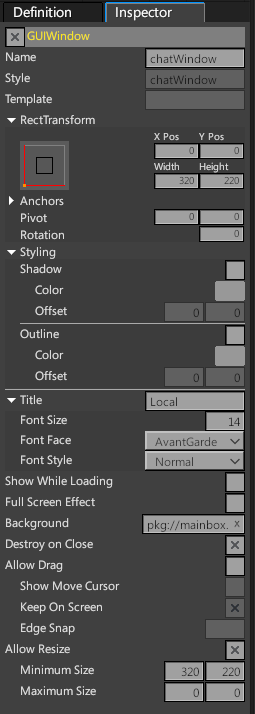UI Editor/Inspector
The Inspector Panel in the UI Editor is a tool for the inspection and modification of the window and components of the UI being edited. The properties for the component selected in the Hierarchy panel are displayed here.
Contents
Common Properties
All UI elements have some properties in common which are displayed topmost in the panel.
Visible
The topmost checkbox controls whether or not this element should be rendered.
Name
The canonical name for the element. This can be used as part of Find commands for components.
Style
An internal identifier (usually derived from the Name) which allows the .ui file to store properties in the side-by-side .style file
Template
The template (if any) the element was originally derived from.
RectTransform
Unity internally uses the RectTransform to control the width, height, anchors, and pivot of the UI element. Check the Unity Documentation for more info.
Styling
All elements support a set of styling properties for displaying shadow/outline on their features. Usually this is used for labels, but can be used on other kinds of UI elements as well.
Panel Layout
All components (not windows) support a set of layout properties for controlling how they appear when inside a panel with its Layout property enabled.
Property Types
Resource Values
Many components support images and audio clips as part of their properties. These values are represented as Resource Values, which are typically defined in the editor using a URL-style path.
pkg:// addresses denote a resource stored within the script package. So pkg://folder/file.png would refer to "file.png" located in the package subfolder "folder".
global:// addresses denote a resource that was shared from another script package by using GUI.RegisterGlobalTexture() or Audio.RegisterGlobalAudio(). This is most often done in global templates and as such often appears on newly created components.
Text
Text components offer an expandable set of additional options for changing the display of their text: font size, style, and face.
Conditional Properties
Some properties are only valid if another property is set. Usually the required property is a boolean property: Minimum and Maximum size only matter if you can resize a window for example. However, in the case of Layout components, some properties are only valid if a layout type is chosen. Conditional properties will be disabled in the editor until the required property is enabled or set.
